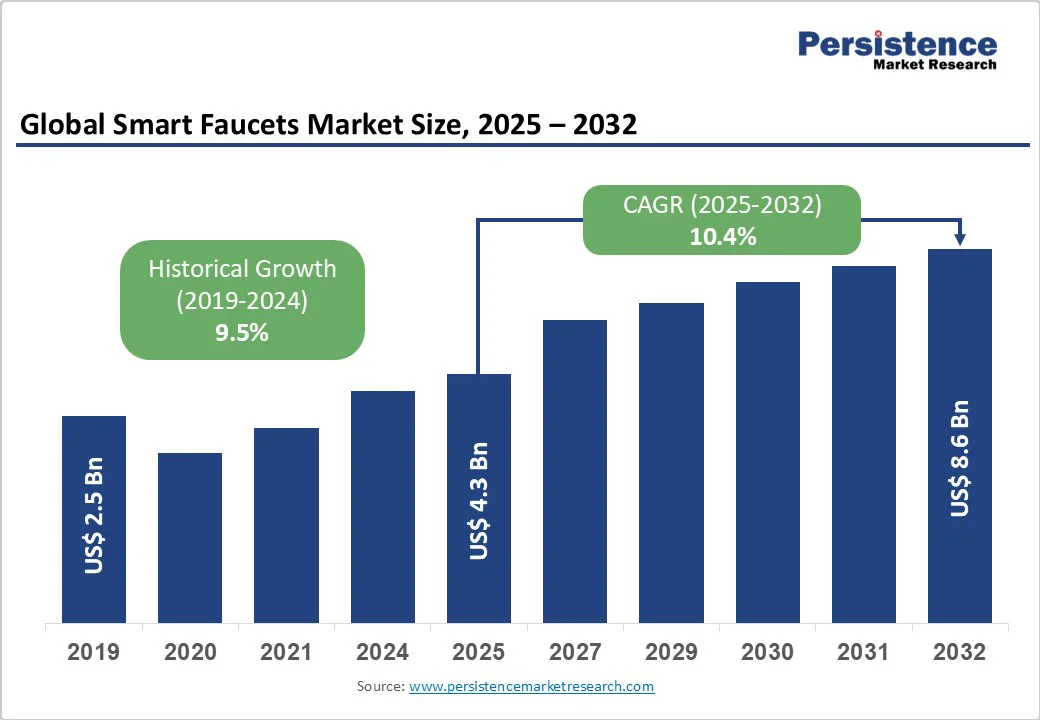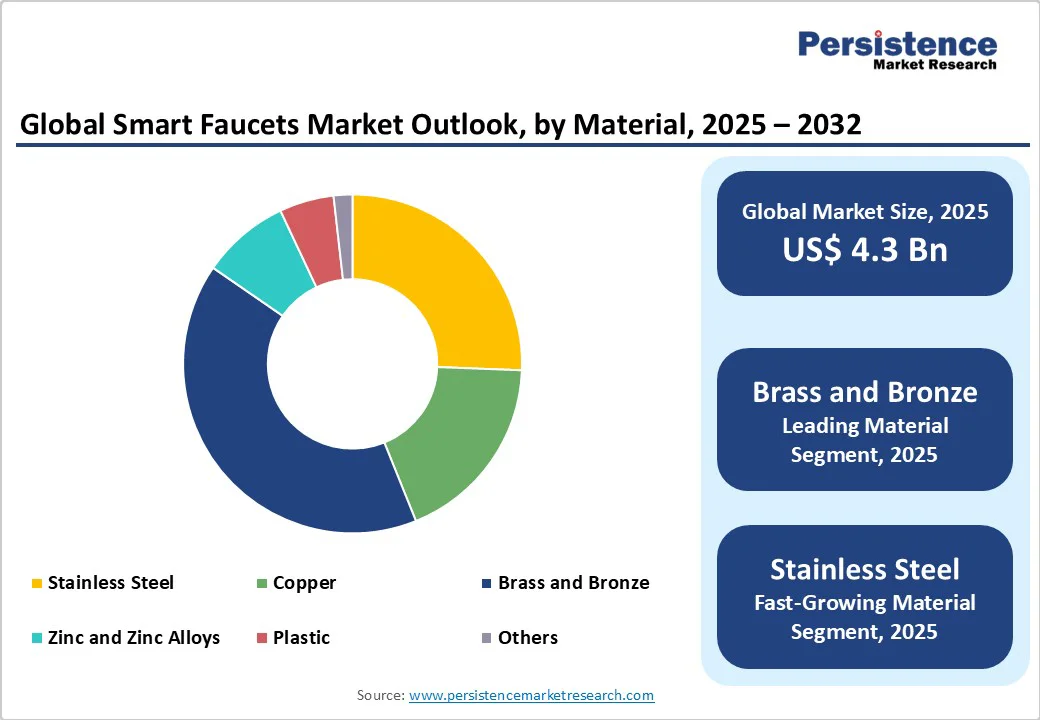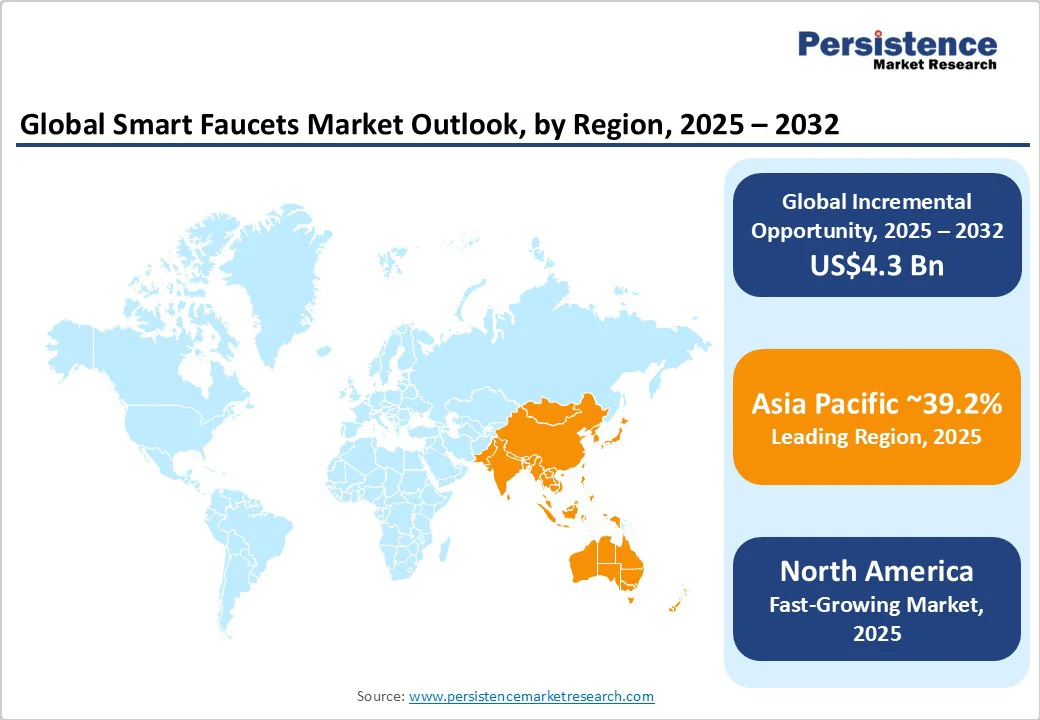ID: PMRREP35759| 177 Pages | 21 Oct 2025 | Format: PDF, Excel, PPT* | Consumer Goods

The global smart faucets market size is likely to be valued at US$4.3 Billion in 2025 and is estimated to reach US$8.6 Billion in 2032, growing at a CAGR of 10.4% during the forecast period 2025 - 2032, driven by touchless operation, which allows users to turn water on and off without physical contact, improving cleanliness and reducing the spread of germs.
| Key Insights | Details |
|---|---|
| Smart Faucets Market Size (2025E) | US$4.3 Bn |
| Market Value Forecast (2032F) | US$8.6 Bn |
| Projected Growth (CAGR 2025 to 2032) | 10.4% |
| Historical Market Growth (CAGR 2019 to 2024) | 9.5% |

Smart faucets provide the advantage of touchless operation, allowing users to turn water on and off without physically touching the fixture. This feature is mainly valuable in kitchens and bathrooms, where hands are often dirty, full, or contaminated. By reducing direct contact, touchless faucets also help minimize the spread of germs and maintain a clean environment.
Leading brands such as Delta Faucet have introduced motion-sensor faucets that respond instantly to hand gestures, providing a smooth and intuitive experience. The combination of convenience, hygiene, and modern design makes touchless operation a compelling driver for both residential and commercial adoption of smart faucets.
Various smart faucets now integrate with smartphone apps, allowing users to control water flow, temperature, and other settings remotely. This capability provides unparalleled convenience, especially in multi-story homes or for users managing water consumption from different locations. For example, Moen’s Smart Water Network app lets homeowners monitor water usage, receive alerts for leaks, and even schedule automated temperature adjustments.
Such remote control functionality appeals to tech-savvy consumers who value efficiency, resource management, and integration with broad smart home ecosystems. This makes it a key driver of market growth in the smart faucet segment.
Despite their unique features, smart faucets can sometimes experience technical hiccups that disrupt user experience. These issues include delays in responding to voice commands, sensors failing to detect hand movements accurately, or connectivity glitches with smart home systems. Such inconsistencies can frustrate consumers and reduce confidence in the product, especially in high-use settings such as commercial kitchens or public restrooms.
Even leading brands such as Moen and Kohler have occasionally reported software updates to fix sensor calibration or connectivity bugs. Frequent technical issues may slow adoption, as users prioritize reliability alongside innovation when investing in smart home appliances.
Smart faucets rely on a constant power source, whether through batteries or direct electrical connections, to function effectively. During power outages or when batteries deplete, the faucets tend to become non-operational, rendering key features such as touchless activation, temperature control, or automated water shut-off unusable.
This dependence can be a prominent limitation in regions with unreliable electricity or for users who neglect regular battery maintenance. Even energy-efficient models with long-lasting batteries are not immune to this challenge, which can affect consumer confidence and slow market growth.
Smart faucets present a key growth opportunity through smooth integration with broad smart home systems. By connecting with platforms such as Amazon Alexa, Google Home, and Apple HomeKit, these faucets can be controlled alongside lighting, security, and HVAC systems, creating a cohesive and automated home experience.
For instance, Kohler’s Konnect line allows homeowners to adjust water temperature and flow using voice commands or scheduled routines, improving convenience and energy efficiency. As smart home adoption rises globally, the ability of faucets to interact with multiple devices positions them as essential components of a connected household, delivering manufacturers a chance to tap into the expanding market for integrated home automation.
The evolving preference for products that combine aesthetic appeal with practical features provides smart faucets with a unique growth pathway. Consumers now seek fixtures that complement modern interiors while delivering novel functionalities such as temperature memory, water conservation settings, and customizable flow patterns.
Brands such as Grohe are embracing this trend by launching sleek, designer faucets with touchless sensors and smart water control, appealing to both luxury homeowners and commercial spaces. By emphasizing stylish yet functional designs, manufacturers can differentiate their products, attract design-conscious buyers, and expand market share in the premium and mid-tier smart faucet segments.
Disc smart faucets are expected to hold a share of nearly 34.6% in 2025, owing to their durability, precision, and smooth operation. Unlike traditional faucets, they use a ceramic disc cartridge that provides consistent water flow control and reduces the risk of leaks over time.
This design ensures a long lifespan and minimal maintenance, making it attractive to both residential and commercial users. The combination of robustness and user-friendly operation makes disc smart faucets a key choice among consumers seeking long-term value and efficiency.
Smart ball faucets are witnessing high popularity owing to their affordability, ease of installation, and versatility. These faucets use a single rotating ball to control water flow and temperature, allowing for simple, intuitive operation. They are mainly favored in regions where cost-effective smart solutions are in demand without compromising functionality. Their adaptability to different sink setups and compatibility with modern smart features contribute to their increasing adoption in the market.
Smart faucets made of brass and bronze held a share of approximately 40.7% in 2025 as these materials deliver excellent durability, corrosion resistance, and a premium look. Brass is resistant to mineral buildup and rust, ensuring long-term functionality in both residential and commercial environments.
Bronze adds an aesthetic appeal with its warm, classic finish, making it popular for luxury bathroom and kitchen designs. The longevity, low maintenance, and elegant appearance of these materials make them a prominent choice for consumers who prioritize both performance and style.
Stainless steel is seeing considerable growth, spurred by its strength, corrosion resistance, and sleek modern appearance. It is highly durable against daily wear, scratches, and exposure to water, making it ideal for high-traffic areas.
Stainless steel is also hygienic and easy to clean, which caters to the rising demand for touchless and sanitary fixtures. Its combination of practicality, longevity, and aesthetic versatility makes it a preferred material in the development of reliable and stylish smart faucets.
Bathrooms are considered the primary application for smart faucets because hygiene and water efficiency are key priorities in this space. Touchless faucets help prevent the spread of germs, which is especially important in public restrooms, hospitals, and high-traffic residential bathrooms.
Also, features such as automatic temperature control and water conservation cater to modern consumer expectations for comfort and sustainability. Owing to the aforementioned factors, the bathroom segment is poised to capture about 60.5% share in 2025.
Kitchens represent an important application for smart faucets due to the frequent requirement for hands-free operation when cooking or cleaning. Touchless and voice-activated faucets allow users to manage water flow without interrupting food preparation, which improves efficiency and reduces contamination risks. Smart features, including temperature presets, water usage monitoring, and pull-down sprayers, further support convenience in residential and commercial kitchens.

Asia Pacific will likely capture a share of nearly 39.2% in 2025, owing to rapid urbanization, increasing disposable incomes, and a rising interest in smart home technologies. China remains the dominant market, benefiting from its extensive manufacturing capabilities and competitive pricing.
The country's push for smart city development and widespread smart home integration continues to propel demand for smart faucets across residential, commercial, and multi-family housing projects.
India is emerging as a key market for smart faucets, mainly in urban areas with rising incomes and aspirations. Companies such as Kohler and Toto are expanding their presence, with Kohler describing India as its fastest-growing market globally.
Japan and South Korea also contribute to the market's growth, augmented by technological developments and high consumer interest in smart home solutions. These countries' superior consumer culture and government support for smart technology integration further bolster the adoption of smart faucets.
In 2025, North America accounted for approximately 26.9% of the market share, accelerated by early adoption of smart home technologies, rising awareness of water conservation, and a robust infrastructure supporting unique plumbing solutions.
The U.S. is at the forefront of growth, boosted by the widespread integration of smart faucets in various sectors. Commercial establishments such as hotels, hospitals, and office buildings are extensively adopting touchless and voice-activated faucets to improve hygiene and operational efficiency.
Consumers are opting for smart faucets that deliver features such as water flow control, temperature regulation, and integration with smart home ecosystems.
Key players in the market include Delta Faucet Company and Moen Incorporated. Delta Faucet Company, a subsidiary of Masco Corporation, has been at the forefront of innovation in plumbing fixtures. Moen Incorporated, part of Fortune Brands Innovations, continues to develop products that cater to the evolving requirements of consumers seeking convenience and sustainability.
In Europe, the market is experiencing a steady growth, propelled by a combination of environmental policies, technological developments, and evolving consumer preferences. In 2024, smart faucets accounted for over 15% of market share, with projections indicating a rise to 20% by 2025.
This growth is fueled by increasing demand for touchless, voice-activated faucets and integration with smart home systems. In addition, the European Water Label program and the EU Water Framework Directive are promoting water conservation, further boosting the adoption of smart faucets.
Oras, a Finland-based manufacturer, stands out as a key player in the regional market. With a superior presence in Finland, where it holds 30 to 80% of the total share, the company is expanding its footprint across Europe.
In July 2025, it acquired the Gustavsberg and Vatette businesses from Villeroy & Boch, improving its product portfolio and market reach. As environmental concerns and smart home adoption continue to rise, the demand for smart faucets is predicted to surge across Europe.

The global smart faucets market consists of leading players such as Moen, Kohler, Delta Faucet, LIXIL Group, and TOTO, collectively holding 28% of the market share in 2025. These companies are focusing on innovation and sustainability to maintain a competitive edge.
For instance, Kohler introduced voice-activated smart faucets in 2024, complying with the surging trend of smart home technologies. Moen's Arbor Smart Faucet provides features such as voice control via Alexa and Google Assistant, automatic water measurement, and temperature indicators.
The smart faucets market is projected to reach US$4.3 Billion in 2025.
Rising demand for touchless operation and smooth integration with smart home systems are the key market drivers.
The smart faucets market is poised to witness a CAGR of 10.4% from 2025 to 2032.
Expansion in emerging markets and focus on eco-friendly designs are the key market opportunities.
American Standard Brands, Kraus USA, and Kohler Co. are a few key market players.
| Report Attribute | Details |
|---|---|
| Historical Data/Actuals | 2019 - 2024 |
| Forecast Period | 2025 - 2032 |
| Market Analysis | Value: US$ Bn |
| Geographical Coverage |
|
| Segmental Coverage |
|
| Competitive Analysis |
|
| Report Highlights |
|
By Product Type
By Material
By Technology
By Application
By Region
Delivery Timelines
For more information on this report and its delivery timelines please get in touch with our sales team.
About Author